Im Gegensatz zu Gas- oder Elektroherden nutzen Induktionsherde Magnetfelder, um das Kochgeschirr direkt zu erhitzen, was sie schneller und reaktionsschneller macht. Diese Hightech-Funktion hat jedoch bei vielen Nutzern auch Fragen aufgeworfen: Braucht man für einen Induktionsherd spezielles Kochgeschirr?
Die Antwort ist ja. Als Profi KochgeschirrherstellerIch werde Ihnen eine ausführliche Einführung in die Gründe geben.
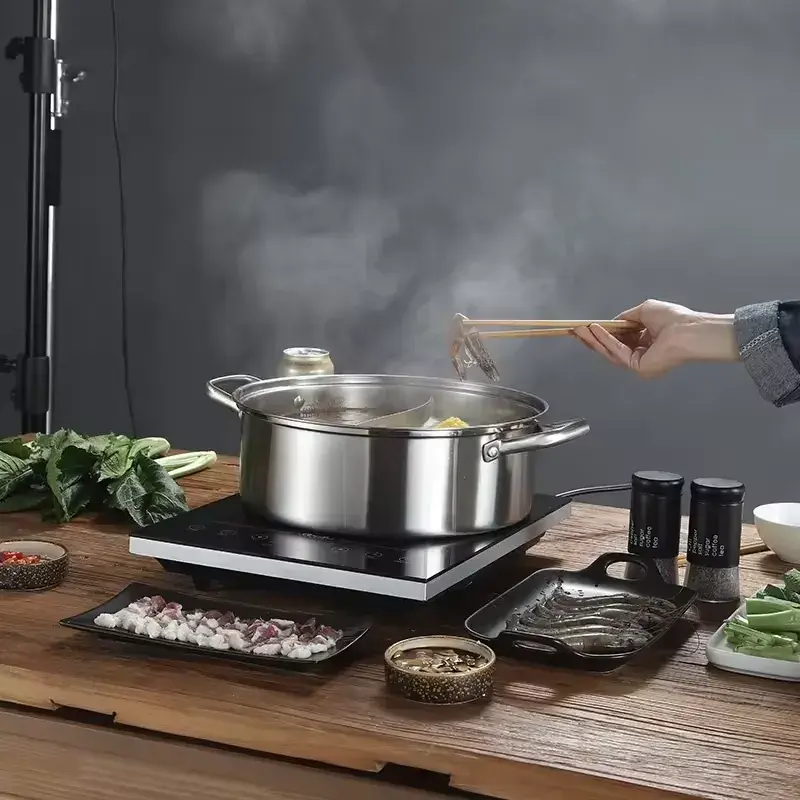
Wie funktioniert das Induktionskochen?
Im Gegensatz zu offenen Flammen oder gewöhnlichen Heizdrähten heizen Induktionskochherde durch elektromagnetische Induktion! Der spezifische Prozess ist wie folgt:
- Erzeugen eines Magnetfeldes: Wenn Sie einen Induktionsherd einschalten, wird Wechselstrom durch eine Spule unter dem Kochfeld geleitet, wodurch ein sich schnell veränderndes Magnetfeld entsteht.
- Induktionserwärmung. Dieses sich verändernde Magnetfeld durchdringt die Herdoberfläche und wirkt auf den Boden des darauf abgestellten Topfes. Wenn der Topfboden aus ferromagnetischem Material besteht, wie z. B. Eisen, einige Arten von rostfreiem Stahl usw., erzeugt dieses wechselnde Magnetfeld unzählige kleine Wirbelströme (elektrische Ströme) im Topfboden.
- Widerstandsheizung: Das Material des Kochgeschirrs selbst weist einen gewissen Widerstand auf. Wenn der Wirbelstrom im Topfboden fließt, wird er aufgrund des vorhandenen Widerstands in Wärmeenergie umgewandelt, wodurch das Kochgeschirr erhitzt wird.
- Konduktionsheizung. Die Wärme vom Topfboden wird schnell auf die Topfwand und die Speisen übertragen, so dass ein Garen erreicht wird.
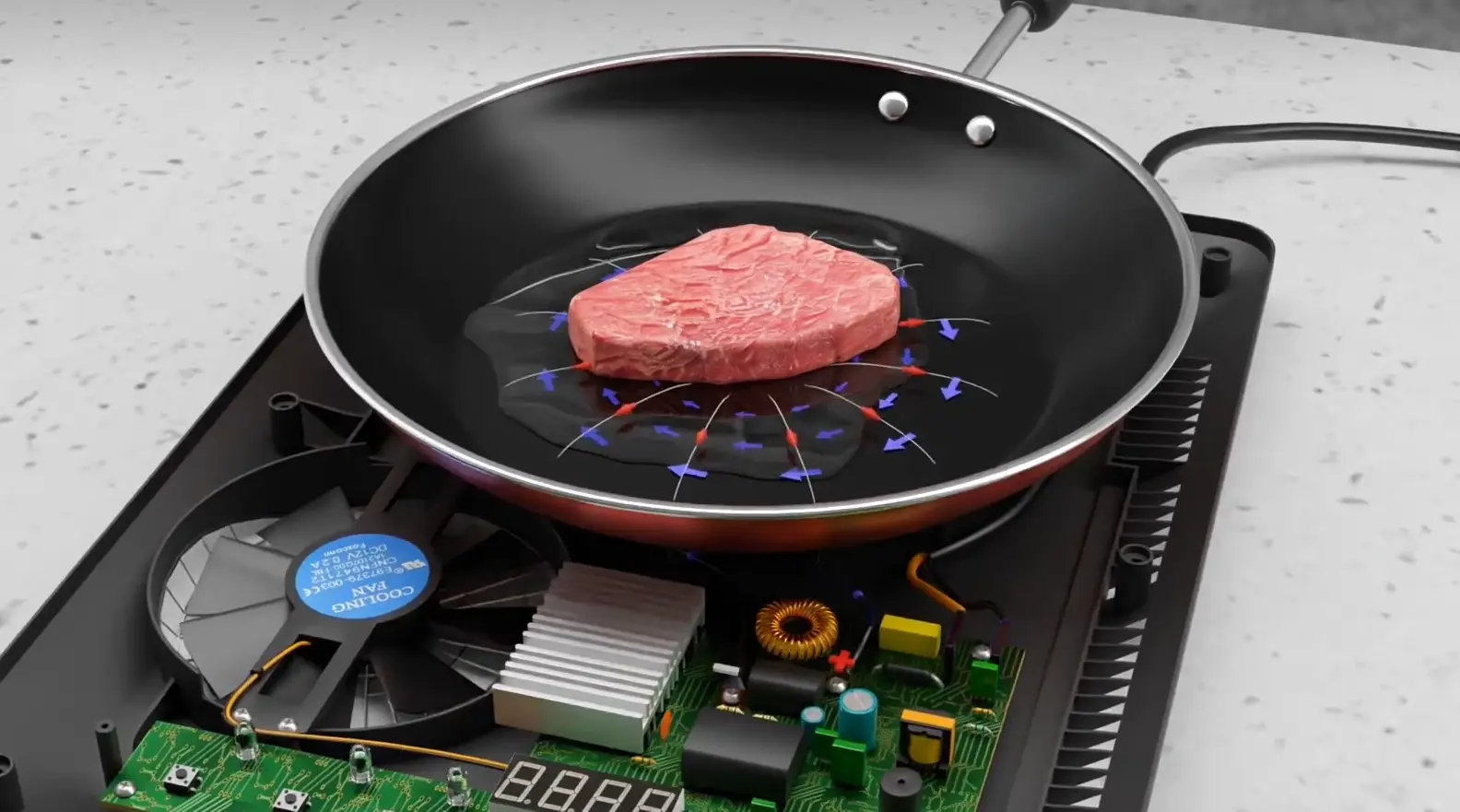
Benötigt man für das Induktionskochen spezielles Kochgeschirr?
Ja, das stimmt. Da Induktion Magnetismus zum Erhitzen nutzt, muss Ihr Kochgeschirr aus ferromagnetischem Material bestehen oder dieses enthalten - ein Material, das magnetisiert werden kann. Wenn Ihre Töpfe oder Pfannen nicht magnetisch sind, kann die Induktion sie nicht erkennen oder erhitzen.
Das bedeutet, dass Ihre alten Aluminium-, Glas- oder Kupfertöpfe möglicherweise nicht funktionieren, es sei denn, sie haben einen magnetischen Boden, der speziell für die Verwendung mit Induktion geeignet ist.
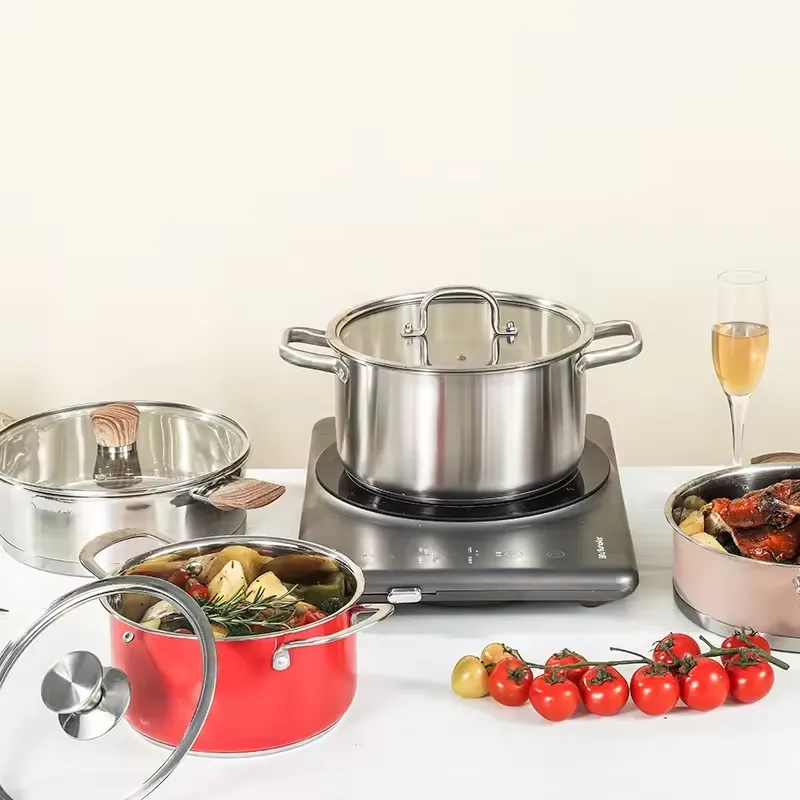
Gängige Materialien, die für Induktionsherde geeignet sind
- Kochgeschirr aus Gusseisen: wie z. B. gusseiserne Bratpfanne, emaillierter Gusseisentopf
- Magnetisches Kochgeschirr aus rostfreiem Stahl: Jeder rostfreie Stahl ist geeignet! Der Topfboden muss eine magnetische Schicht aufweisen. Am einfachsten ist es, einen Magneten zu benutzen, um den Boden anzuziehen. Wenn er sich anziehen lässt, ist er im Allgemeinen brauchbar.
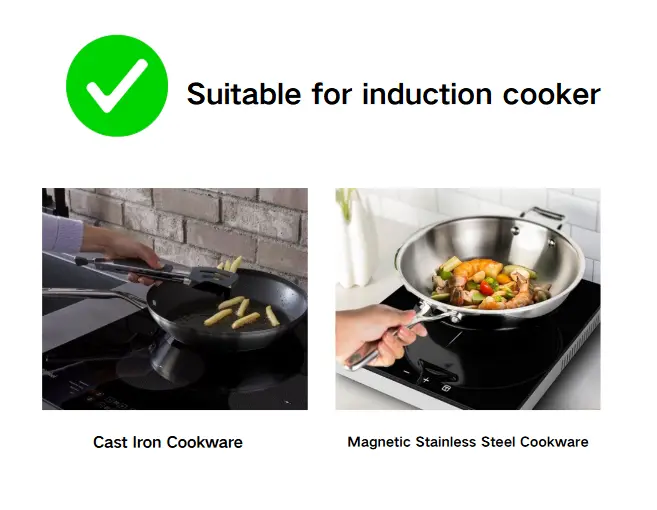
Nicht für Induktionsherde geeignete Materialien
- Kochgeschirr aus reinem Aluminium
- Kochgeschirr aus reinem Kupfer
- Kochgeschirr aus Glas
- Gewöhnliches Keramik-Kochgeschirr
- Kochgeschirr aus Edelstahl 304 und 316 ohne magnetisch leitende Schicht
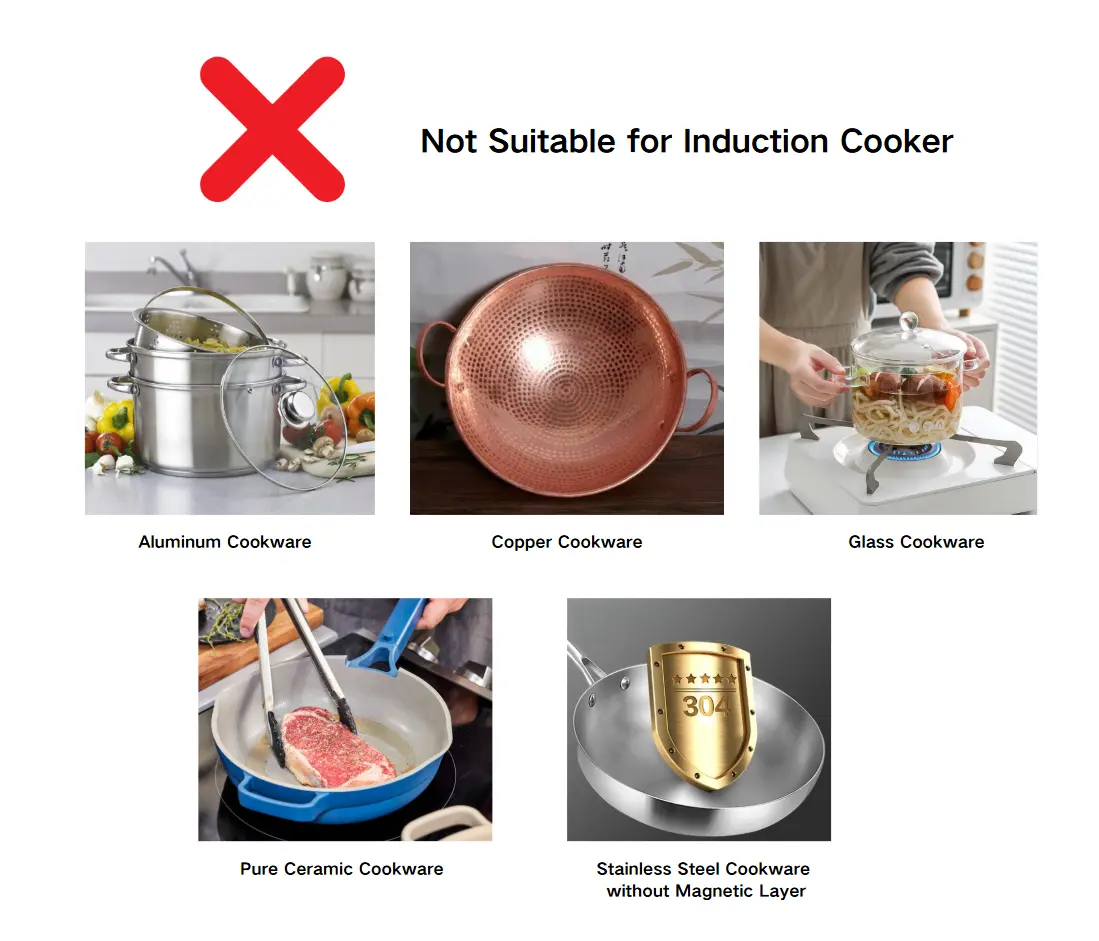
Sonstige Anforderungen an Induktionskochgeschirr
- Der Boden des Topfes ist flach: Der Boden des Kochgeschirrs muss so flach und glatt wie möglich sein, um einen engen und großflächigen Kontakt mit der mikrokristallinen Glasplatte des Induktionsherds zu gewährleisten. Jede Unebenheit (z. B. konvex oder konkav) führt zu schlechtem Kontakt, beeinträchtigt die Effizienz der Magnetfeldinduktion, führt zu ungleichmäßiger Erwärmung oder sogar zum Ausfall des Geräts.
- Der Durchmesser des Bodens des Kochgeschirrs ist groß genug: Der Bodendurchmesser des Kochgeschirrs muss normalerweise ≥8 cm betragen. Wenn er zu klein ist, kann der Induktionsherd ihn nicht erkennen und schützt sich automatisch, ohne zu starten.
Vorteile der Verwendung des richtigen Induktionskochgeschirrs
Bei der Verwendung von kompatiblem Kochgeschirr geht es nicht nur darum, ob das Kochfeld funktioniert - es hat auch Auswirkungen auf die Leistung. Die Vorteile umfassen:
- Schnelleres Aufheizen und Kochen
- Verbesserte Energieeffizienz
- Gleichmäßige Wärmeverteilung
- Leichtere Säuberung
- Längere Lebensdauer von Kochgeschirr und Induktionsherd
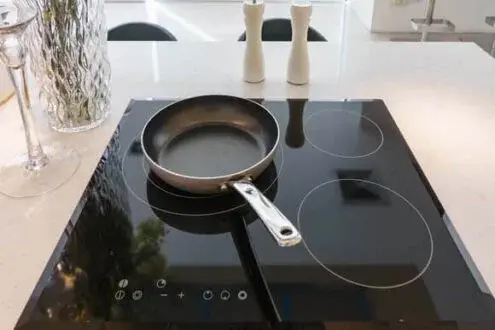
So prüfen Sie, ob Ihr Kochgeschirr für Induktion geeignet ist
Probieren Sie Folgendes aus, um zu prüfen, ob Ihr Kochgeschirr für das Induktionskochen geeignet ist.
- 🔍 Magnet-Test: Kleben Sie einen Magneten an den Boden des Kochgeschirrs. Wenn der Magnet gut anzieht, ist es höchstwahrscheinlich kompatibel.
- 🔖 Suchen Sie das Symbol: Viele Hersteller haben ein Induktionsspulensymbol (⭘) auf dem Sockel oder der Verpackung angebracht.
- 📦 Lesen Sie das Etikett: Achten Sie auf Formulierungen wie "für Induktion geeignet" oder "für alle Herde geeignet".
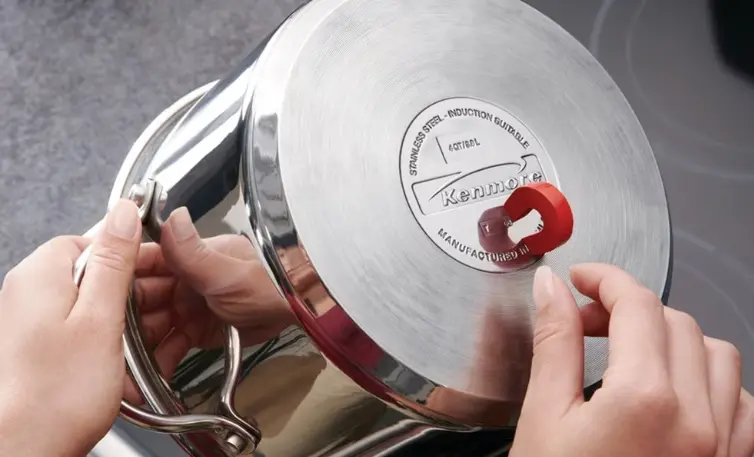
Funktioniert Induktionskochgeschirr auch auf Gasherden?
Viele Menschen kaufen ein spezielles Induktionskochgeschirr, wenn sie auf einen Induktionsherd umsteigen, aber sie fragen sich auch, ob diese Töpfe und Pfannen auch für herkömmliche Gas- oder Elektroherde geeignet sind. Die Antwort lautet: Die meisten Töpfe und Pfannen, die für Induktionsherde geeignet sind, können auch auf Gasherden verwendet werden, aber man muss auf einige Details achten.
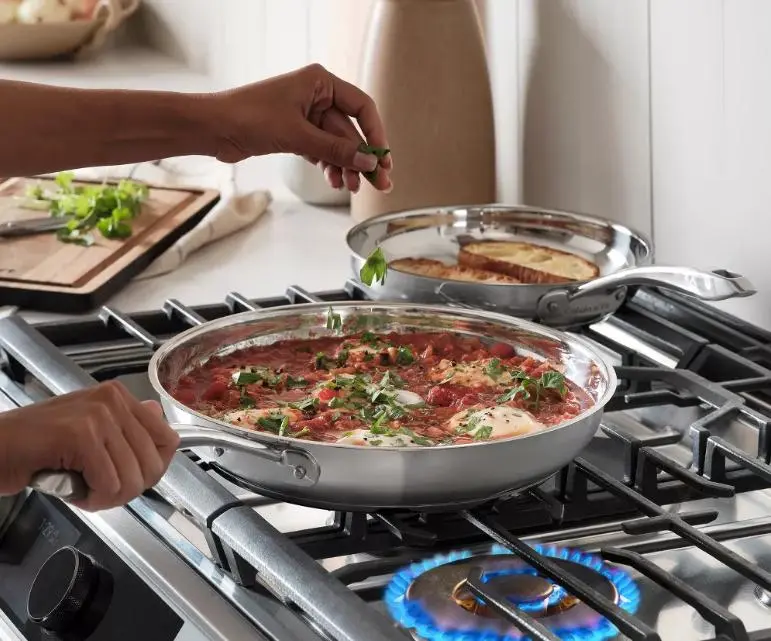
Warum sind Induktionskochgeschirre für Gasherde geeignet?
- Induktionskochgeschirr hat in der Regel einen massiven Metallboden, der der Hitze einer offenen Flamme standhält.
- Edelstahl, mehrschichtige Verbundböden, Gusseisen und andere Materialien sind bei Induktionskochgeschirr üblich und eignen sich auch für die Verwendung auf Gasherden.
- Die meisten "Alle Herdarten"-Kochgeschirre decken Induktions-, Gas-, Elektro-, Keramikherde und andere Typen ab.
Verbreitete Mythen über Induktionskochgeschirr
Lassen Sie uns mit einigen Mythen aufräumen, die die Käufer verwirren könnten:
- ❌ "Alle nichtrostenden Stähle funktionieren" - Falsch. Nur magnetische Sorten funktionieren.
- ❌ "Induktion ist unsicher" - Tatsächlich ist sie aufgrund der kühleren Oberflächen und der automatischen Abschaltfunktion sicherer.
Schlussfolgerung
Ja, Induktion erfordert spezielles Kochgeschirr, aber das bedeutet nicht, dass Sie bei Null anfangen müssen. Für Induktion braucht man eine Pfanne mit einem ferromagnetischen Boden, einer ebenen Oberfläche und der richtigen Größe. Solange sie diese Anforderungen erfüllt, spielt es keine Rolle, ob es sich um eine brandneue Pfanne handelt oder um eine, die Sie bereits zu Hause haben.
Über Purecook
Wenn Sie als Einzelhändler, Großhändler oder Marke auf der Suche nach qualitativ hochwertigem induktionsgeeignetem Kochgeschirr sind, ist Purecook Ihr vertrauenswürdiger Produktionspartner.
Als Fachmann Kochgeschirrhersteller Mit mehr als 30 Jahren Erfahrung als OEM und ODM ist Purecook auf die Großhandelsproduktion von Kochgeschirr für die moderne Küche spezialisiert, einschließlich induktionsfähigem Mehrschicht-Edelstahl-Kochgeschirr und antihaftbeschichteten Pfannen, und wir unterstützen kundenspezifische Materialien, Größen, Beschichtungen und Verpackungen.
Wenden Sie sich noch heute an Purecook, um mehr über unser komplettes Angebot an Induktionskochgeschirr zu erfahren und ein Großhandelsangebot anzufordern.
Kontakt
Zögern Sie nicht, uns anzurufeninfo@purecook.com
Zögern Sie nicht uns zu kontaktierenNr. 68 Xianhua Road, Huaqiao-Village, Caitang Town, Chao'an District, Cha ozhou City, Provinz Guangdong
